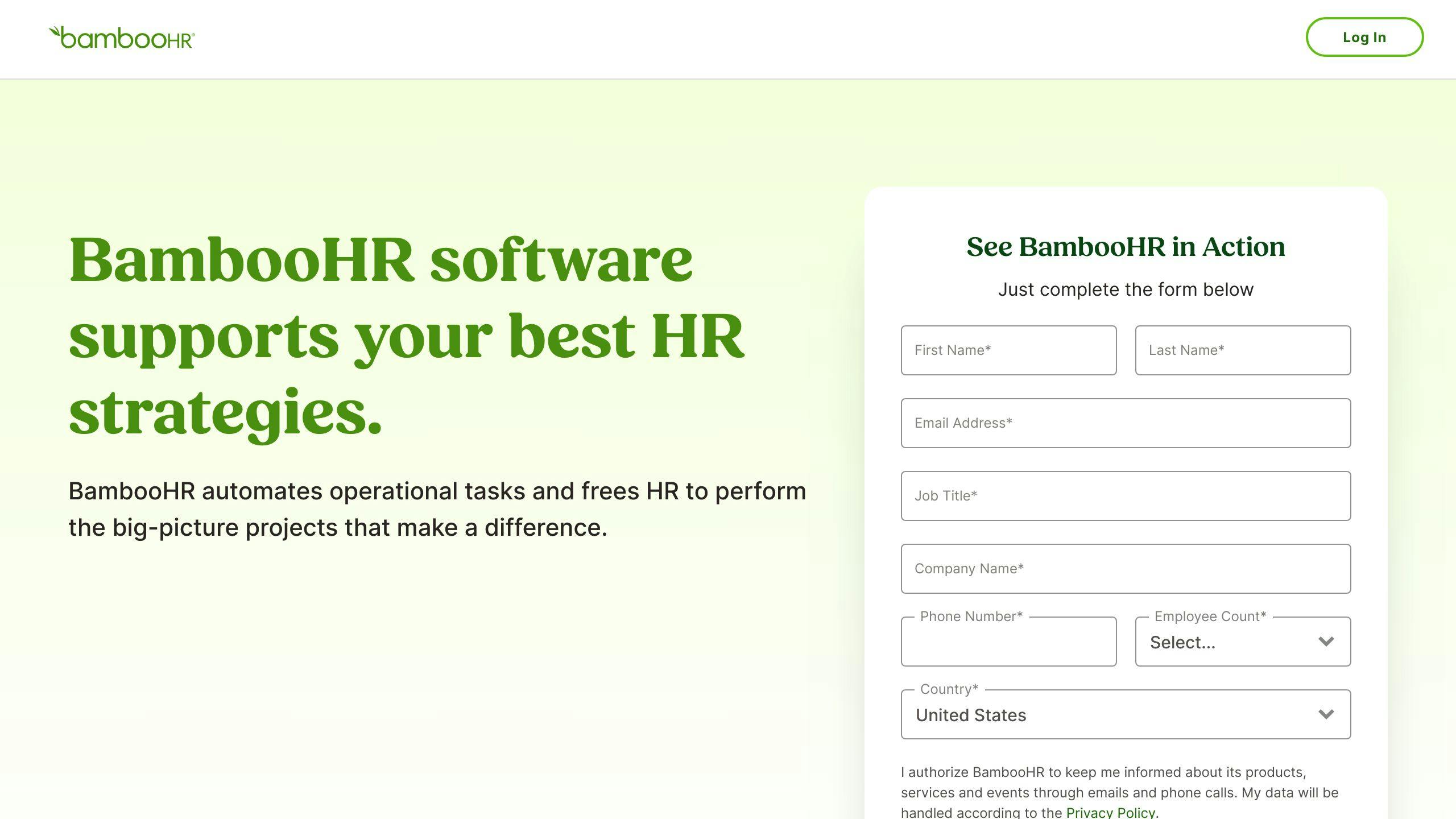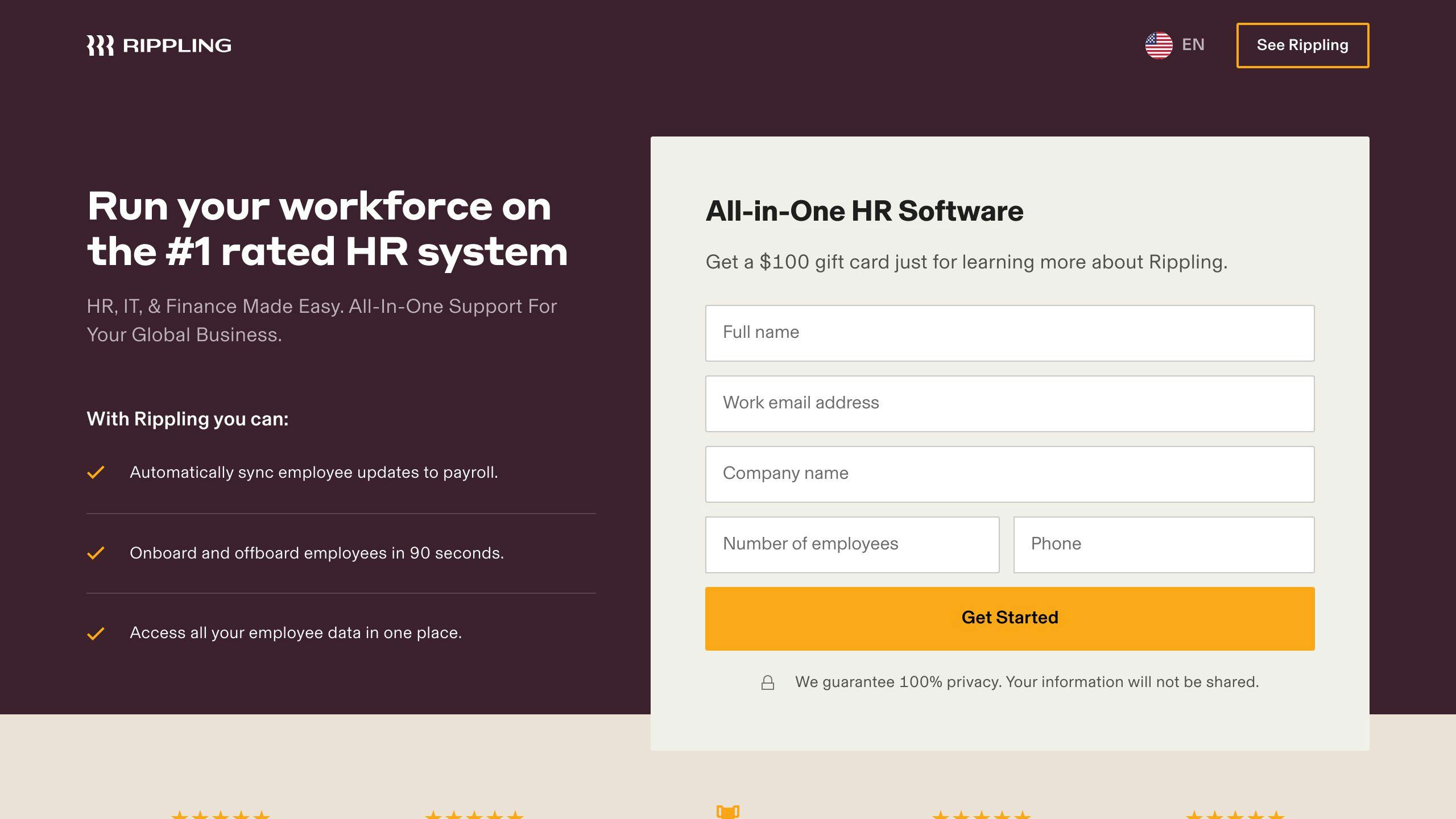Choosing the top HR management software for small businesses is crucial for handling tasks like hiring, payroll, and benefits management efficiently. This guide compares five leading options:
- BambooHR: Known for its user-friendliness and comprehensive HR tools.
- TriNet HR Platform: Offers a wide range of HR services in one package.
- Rippling: Integrates HR with IT and finance for a unified approach.
- Paycor: Provides a complete HR solution with industry-specific packages.
- UKG Ready: Combines HR tasks into one user-friendly portal, suitable for businesses of all sizes.
Each software has its pros and cons, but all are designed to make HR tasks simpler and more efficient. The best choice for your business will depend on your specific needs, budget, and growth plans. Trying out free versions can help you decide which software fits best.
Quick Comparison
| Software | User-Friendly | Comprehensive Tools | Pricing | Scalability | Customer Support |
|---|---|---|---|---|---|
| BambooHR | Yes | Yes | Starts at $99/month | Yes | High |
| TriNet HR Platform | Yes | Yes | Starts at $125/month | Yes | High |
| Rippling | Yes | Yes | Starts at $8/employee/month | Yes | Medium |
| Paycor | Yes | Yes | Starts at $99/month | Yes | High |
| UKG Ready | Yes | Yes | Charges per employee/month | Yes | High |
When implementing new HR software, remember to choose a system that aligns with your business's size, industry, and budget. Consider ease of use, essential features, scalability, and support to ensure a smooth transition and efficient ongoing HR management.
Ease of Use
You want software that's easy for everyone to use, not just the tech-savvy folks. Here's what matters:
- A simple main page that lets you quickly see important info
- The option to change how things work, based on who's using it
- Helpful tips and support right where you need them
- A mobile app so you can do things on the go
Key Features
The software should have everything a small business needs, such as:
- Tools to help you find and hire people
- A way to welcome new employees
- Managing paychecks
- Handling health and other benefits
- Checking in on how employees are doing
- Training options
- Tools to understand and improve your team
It's best if these parts work well together without any hassle.
Pricing
It should fit your budget. Look for clear prices for each part of the service. There should be different levels, from basic to more advanced, and options like trying it out for free or paying monthly or yearly.
Scalability
As your business gets bigger, the software should be able to keep up without needing to switch to something else.
Customer Support
Good support is crucial. You should be able to get help through phone, email, or chat. There should also be a help center with answers to common questions and training materials.
By checking these areas, you can find the HR software that fits your business's needs and budget.
Comparative Analysis of HR Management Software
1. BambooHR

Ease of Use
BambooHR is designed to be easy for anyone to use, not just the experts. It has a straightforward main page that quickly shows you what you need to know. You can adjust it based on who's using it, and if you get stuck, there's easy-to-find help and a chat option. Plus, there's an app so you can do things from anywhere.
Key Features
BambooHR covers everything from hiring to saying goodbye to employees. Its main tools include:
- Tracking applicants
- Helping new employees get started
- Managing pay
- Taking care of health and other benefits
- Reviewing how employees are doing
- Training options
- Detailed reports
All these features work smoothly together.
Pricing
BambooHR has clear pricing, starting at $99 a month for small teams up to 50 people. If you have more people, the price adjusts, but they offer discounts for bigger teams. You can try it out for free to see if it fits your needs.
Scalability
BambooHR grows with your business. It offers plans for bigger teams that include more features, so you don't have to switch to a different system as you grow.
Customer Support
You can reach out to BambooHR through email, chat, or phone. They also have an online place where you can find answers and learn how to use the system. People really like the support team at BambooHR.
2. TriNet HR Platform
Ease of Use
TriNet HR Platform makes things simple. It's easy to get around with a clear main page that shows you the important stuff right away. You can change the setup for different people using it, and if you're ever confused, there's help just a click away. Plus, it comes with a mobile app, so you can use it wherever you are.
Key Features
TriNet offers a bunch of helpful tools in one place:
- Finding and keeping track of job applicants
- Welcoming new employees
- Handling pay
- Signing up for and managing benefits
- Checking how employees are doing
- A system for learning new things
- Reports and insights about your HR stuff
All these parts work together without any trouble.
Pricing
TriNet's prices are clear and fair. It starts at $125 a month for teams with up to 10 people. If your team is bigger, the price goes up, but they cut you a deal for having more people. You can also try it out for free to see if it's a good fit.
Scalability
TriNet grows with your business. It has bigger plans with more stuff as you need it, so you don't have to switch to a different platform when your business gets bigger.
Customer Support
You can get help through email, phone, or live chat. They also have a big help center and a community forum where you can find answers. People say the support team is really helpful and quick to respond.
3. Rippling

Ease of Use
Rippling is made to be easy for everyone to use. It has a clear dashboard where you can quickly see important stuff. You can set it up so different people see different things, depending on their job. If you need help, there are simple guides and a help section. Plus, there's an app so you can use it on your phone.
Key Features
Rippling brings together HR, IT, and finance stuff all in one place. Its main features are:
- Setting up automatic tasks based on employee info
- Lots of ready-to-use task templates
- Signing up for and managing benefits
- Handling payroll
- Keeping track of job applicants
- Training tools
- Easy-to-make reports
Pricing
Rippling lets you pick what you need:
- Starts at $8 for each employee every month
- Just the HR part is $5 for each employee every month
- You can add more tools if you need them
If you have a lot of employees, they'll give you a discount.
Scalability
Rippling can grow with your business. You can add more tools as you get bigger, without having to switch to a new system.
Customer Support
You can get help through:
- Phone and email from Monday to Friday, 6AM-5PM PT
- An online help center with guides, FAQs, and training stuff
4. Paycor
Ease of Use
Paycor is built to be easy for everyone. It has a clear dashboard where you can find what you need fast. You can change settings for different roles, and if you need help, there are simple tips. Plus, you can use it on your phone with their app.
Key Features
Paycor's main features include:
- Tools for posting jobs, screening applicants, and keeping track of candidates
- Onboarding tools for paperwork, training, and setting up equipment
- Handling payroll, including direct deposits and taxes
- Managing benefits
- Tracking employee performance and goals
- A system (LMS) for training
- Reports on HR stuff
Everything works together smoothly.
Pricing
Paycor's prices start at $99 a month plus $5 for each employee. For bigger teams, they'll figure out a price after talking with you. There are also one-time fees for setting things up and training. You can try it for free with a demo account.
Scalability
Paycor says it can grow with any size business. They have seven special packages for different industries as your business changes.
Customer Support
You can get help through phone, email, or chat from Monday to Friday, 8AM to 8PM Eastern. They also have online guides and FAQs. People say the support team is friendly and quick to help.
5. UKG Ready
Ease of Use
UKG Ready makes things easy. It has a clear dashboard where you can quickly see the important stuff. You can set it up for different people, and it guides you through your tasks. If you need help, there are tips and help right there. Plus, you can use it on your phone.
Key Features
UKG Ready combines everything you need for HR in one place:
- Finding and keeping track of people applying for jobs
- Helping new employees get started
- Managing pay
- Signing up for and managing benefits
- Checking how employees are doing
- A system for learning new things (LMS)
- Reports on your HR activities
This makes it so you don't have to switch between different systems.
Pricing
UKG Ready charges per employee each month. The exact cost depends on what you need, how many employees you have, and the features you want. They might lower the price if you have a lot of employees. You can try it for free to see if it's right for you.
Scalability
UKG Ready can grow with your business, from small to very big. They have different packages for when you grow. You can add more HR stuff as you need it.
Customer Support
You can get help through phone, email, chat, and social media. They have an online place with training materials, documents, and a place to find answers. Help is available on weekdays from 5am-6pm PT. People say the support team is really helpful and quick to answer.
Pros and Cons
Let's look at the good and not-so-good points of each top HR software. This will help you see which one might work best for your small business:
| Software | Pros | Cons |
|---|---|---|
| BambooHR | - Super user-friendly - Handles all the main HR tasks - Pricing is clear and fits the budget - Helpful customer service |
- You might have to pay more for extra features - Could improve how it handles reports |
| TriNet | - Straightforward to use - Puts all HR tools in one spot - Won't break the bank - Grows with your business |
- Charges extra at the start - Some folks have had issues with help and support |
| Rippling | - User-friendly and adaptable - Mixes HR with IT and finance stuff - You pay per person - Lets you add more features as you need them |
- Help is not available all the time - It's a newer option, so still figuring some things out |
| Paycor | - Easy for anyone to use - Complete HR package - Special options for different jobs - Reliable support |
- Pricing can be tricky - Starting and training costs are high |
| UKG Ready | - Easy to find your way around - All HR needs in one place - Works for both small and big businesses - Support is good but only on weekdays |
- Adding more services can get pricey - Help is only available during the week |
BambooHR is great because it's easy for anyone to start using right away. It covers all the basics a small business needs, and the price is right. The downside? You might have to pay extra for some things, and it could do a better job with reports.
TriNet keeps it simple too, with all the HR tools you need in one place. It's good for your budget and can grow with your business. The main hitches are the extra fees at the beginning and some issues with getting help.
Rippling is cool because it brings together HR, IT, and money matters. It's flexible, so you can add more features as your business grows. Since it's newer, its support isn't as broad as others yet.
Paycor offers a full HR experience and has solid support. But, the pricing can be a bit complex, and there are extra charges for getting started and training.
UKG Ready is good for keeping everything HR-related in one spot, no matter if you're small or getting bigger. People like its features and the help they get. The only downsides are the costs can go up if you want more features, and support is only available during the week.
By looking at these points, small business owners can figure out which software fits their needs, budget, and plans for growing. Trying out free trials can also give you a better feel for how they work.
sbb-itb-d1a6c90
Best Practices for Implementing HR Management Software
Putting in a new HR management software might sound tough, but if you follow some key steps, it'll go smoothly. Here's how to make sure your new system starts off right:
Choose the Right Software
- Take your time to pick a software that fits what your business needs, including how big it is, what industry you're in, and your budget.
- Look for a system that's easy to use, works well with other tools you use, can grow with your business, and gives you useful insights.
- Make sure everyone who will use it or be affected by it agrees it's a good choice early on.
Set Realistic Timelines
- Plan for the setup to take a few months, usually between three to six.
- If you're changing a lot of systems, do it step by step.
- Start with the simple stuff and add more complex features later.
Clean Up Data
- Check and update all the info you have on employees.
- Get rid of any mistakes, old data, or duplicates.
- Make sure the info is ready to move to the new system without issues.
Create a Detailed Implementation Plan
- Write down your goals, steps, who's doing what, when things should happen, and how you'll know it's working.
- Plan training and pick people who will help others get used to the new system.
- Tell everyone what's happening and keep them updated.
Get Employee Buy-In
- Show how the new system makes things better for the people using it.
- Involve employees from the start and listen to their feedback.
- Make using the new system part of their job performance.
Refine Processes Along the Way
- Look at how you do things and see if there's a better way.
- Change the system settings to match how you've improved your processes.
- Keep asking for feedback to make the system and how you use it better.
By following these steps, small businesses can move to a new HR system without too much trouble, get everyone on board, and make the most of the new tools.
Conclusion
After looking at different HR software for small businesses, we found some that really stand out because they're easy to use, don't cost too much, have great features, can grow with your business, and offer good help when you need it.
BambooHR is a top choice because it's super easy to use and has everything small teams need for HR tasks. It makes adding new employees and managing your team simple, and you can see useful information through its reports. The best part? It starts at $99 a month.
If you're looking for something that does more than just HR, Rippling is a great pick. It puts HR, IT, payroll, and benefits all together in one system that does things automatically. And you only pay for what you use, starting at $8 per employee each month, which is great for saving money.
Paycor is perfect for small to medium businesses that need a complete HR system with payroll included. It helps you handle all HR tasks and makes sure you follow the laws in all states. It's designed to make your HR work easier.
Businesses that like to let employees and managers do HR tasks on their own will like UKG Ready. It has a user-friendly portal that lets people take care of common HR things by themselves. This means your HR team can focus on bigger projects.
In the end, the best HR software for your business depends on what you need. Knowing what you're looking for helps you choose the right system. Trying out free versions of these top options can help you see which one fits your business best in terms of being easy to use, having the features you need, and fitting your budget.
FAQs
Here are some common questions and straightforward answers about picking and using HR management software for small businesses:
What features are important in HR software?
Look for these main features:
- An applicant tracking system for handling job ads and candidates
- Tools for welcoming and setting up new employees
- Managing paychecks, including setting up direct deposit and handling taxes
- Signing employees up for benefits and managing those benefits
- Keeping track of how employees are doing and their goals
- A learning management system (LMS) for training
- Tools for analyzing and reporting HR data
How much should I expect to pay for HR software?
Prices can range a lot, usually between $50-$150 per employee each month. Bigger businesses might get discounts. Keep in mind there might be one-time costs for setting things up and training. Many options let you try them for free first.
What's the difference between HCM and HRIS software?
- HRIS focuses on keeping and managing employee info.
- HCM software does more, like managing talent, payroll, time tracking, and more. Many systems now offer both HRIS and HCM features.
How long does it take to start using new HR software?
Expect to spend 3-6 months to fully set up. Faster options exist that take 4-8 weeks to start but might offer less customization. Going step by step can make the change smoother.
How do I get my team to use new HR software?
- Get them involved early and listen to their suggestions.
- Explain how it makes things easier for them, like being able to use it on their phones.
- Provide training and support when starting.
- Have some team members help guide others.
- Make using the new system part of their job goals.
What if my business gets too big for the HR software?
Many HR systems can grow with your business. Look for software that lets you easily add more features or upgrade as needed. If you have to switch, make sure you can move your data to the new system.
How do I choose the right software?
Focus on finding software that's easy to use, has the main features you need, works well with other tools you use, offers good support, and has clear pricing. Trying it out for free can help you see if it's a good fit.
What benefits does HR software bring?
You can look forward to your business running more smoothly, better handling of hiring and managing employees, less risk of breaking laws, making decisions based on data, a better workplace for everyone, and HR being able to focus on big-picture stuff.
Related Questions
What is the most popular HR software?
In 2024, some of the top HR software that many people like are:
- Workday for managing workers around the world
- Zenefits for keeping track of freelancers
- ClickUp for staying organized
- UKG Pro for smart features that use AI
- ADP Workforce Now for making sure payroll follows the rules
- Sage HR for letting you change things to fit your needs
Which software is mostly used in HR department?
ADP Workforce Now is a favorite for many. Other widely used HR software includes:
- SAP SuccessFactors HXM - Great for big companies
- Rippling - Good for medium-sized businesses
- BambooHR - Perfect for smaller businesses
How much does BambooHR cost per month?
The cost of BambooHR depends on how many people work for you:
- $75/month for up to 10 employees ($4.25 for each extra person)
- $150/month for up to 20 employees ($7.25 for each extra person after that)
So, for a team of 30, BambooHR would cost $262.50/month.
How do I choose the best HRIS software?
Here's how to pick the best HRIS software for you:
- Think about what you need.
- Look at what your organization needs.
- Consider your budget, how much time you have, and any tech limits.
- Compare different software to your needs.
- Choose a team to help put the new software in place.
The key is to find a software that matches what you need and can do, and trying it out for free can help you decide.


